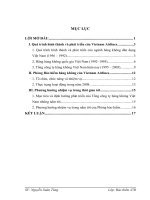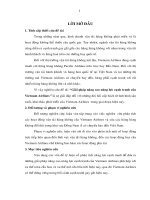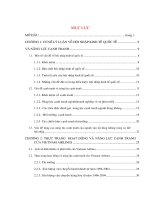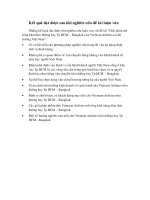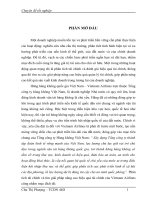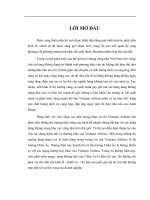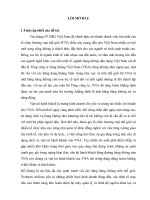Topic Vietnam Airlines.pdf
Bạn đang xem bản rút gọn của tài liệu. Xem và tải ngay bản đầy đủ của tài liệu tại đây (1.62 MB, 15 trang )
<span class="text_page_counter">Trang 1</span><div class="page_container" data-page="1">
<b>NAME – IDMISSIONTrần Thị Diễm Hương - 27202243998VI- GOALS ACHIEVED</b>
<b>STRATEGIES OF VIETNAM AIRLINESNgơ Thị Hồi Thương - 27202202544I – OVERVIEW</b>
<b>II- HISTORY OF FORMATIONIV- CHALLENGES OF BECOMING AN INTERNATIONAL COMPANY (7) Trần Huỳnh Trúc Linh - 27212242547V- FUTURE DEVELOPMENT </b>
<b>STRATEGIES OF VIETNAM AIRLINESThái Thị Huỳnh Như - 27202222137IV- CHALLENGES OF BECOMING AN </b>
- Vietnamese name: Vietnam Airlines Corporation - Joint Stock Company - English name: Vietnam Airlines JSC
- Abbreviated name: Vietnam Airlines
<b>II - HISTORY OF FORMATION:</b>
To be as successful as today, the national airline Vietnam Airlines has gone through a long journey of growth and development. That development process can be summarized as follows: - January 1956: The Government decided to establish the Civil Aviation Department, marking the birth of the aviation industry in Vietnam with a rather limited fleet, only 5 propeller aircraft. - September 1956: The first flight took off.
</div><span class="text_page_counter">Trang 2</span><div class="page_container" data-page="2">- From 1976 - 1988: The flight network was expanded to China, Cambodia, Malaysia, Singapore, Philippines, and Laos. Vietnam civil aviation officially joined the International Civil Aviation Organization (ICAO).
- April 1993: Vietnam National Airlines was officially formed.
- May 27, 1995: Vietnam Airlines Corporation was established with Vietnam Airlines as its core. - October 20, 2002: The Golden Lotus officially became the symbol of Vietnam Airlines. 2006: Vietnam Airlines received a certificate of operational safety from the International Air Transport Association (IATA) and officially joined IATA.
- June 10, 2010: Vietnam Airlines officially became the 10th member of the global airline alliance - SkyTeam.
- July 12, 2016: Vietnam Airlines was recognized as a 4-star airline by the British Airline Review and Rating Organization SkyTrax.
<b>III - PROCESS - HOW TO BECOME AN INTERNATIONAL COMPANY:</b>
The process of Vietnam Airlines becoming an international company is a long and complex process, including many factors and stages. Here is a brief summary of some of the key steps the airline has taken to achieve its current state:
<b>Formation and domestic operations (1956-1970): Vietnam Airlines, formerly known as</b>
Vietnam Civil Aviation, was established in 1956 with support from the Soviet Union and China. The airline mainly operates domestic flights with a fleet of small propeller aircraft.
<b>Expanding to Southeast Asia (Late 1970s-1980s): In the late 1970s and early 1980s, Vietnam</b>
Airlines expanded its international routes to neighboring countries in Southeast Asia such as Laos, Cambodia, and China. China, Thailand, Philippines, Malaysia, Singapore. It also joined the International Civil Aviation Organization (ICAO) in 1980.
<b>Restructuring and modernization (1989-1990): In 1989, the airline was restructured as a </b>
state-owned enterprise and renamed Vietnam Airlines. The airline began modernizing its fleet with more advanced aircraft, such as the Boeing 727 and Airbus A320. It also improves service quality and safety standards.
<b>Formation of Vietnam Airlines Corporation (1995): In 1995, Vietnam Airlines became the</b>
core enterprise of Vietnam Airlines Corporation with the goal of diversifying business activities and increasing competitiveness. The corporation includes 20 service companies related to the aviation industry.
<b>Brand innovation and alliances (2002-2010): In 2002, Vietnam Airlines introduced a new logo</b>
featuring a golden lotus, a symbol of Vietnamese culture and hospitality. The airline also launched the Lotusmiles frequent flyer program and upgraded the in-flight entertainment system. In 2010, the airline became a member of SkyTeam, the global airline alliance, expanding its network and benefiting.
</div><span class="text_page_counter">Trang 3</span><div class="page_container" data-page="3"><b>IPO and Strategic Partnership (2014-2016): Vietnam Airlines launched its initial public</b>
offering (IPO) in 2014, switching to a joint stock company model. In 2016, the airline chose ANA Holdings as its strategic partner, strengthening cooperation with the Japanese airline group.
<b>Fleet upgrade and recognition (2015-2020): Vietnam Airlines became the first airline in Asia</b>
and the second in the world to operate the Airbus A350-900 in 2015, improving long-haul flight capacity. The airline also received a Boeing 787-10 Dreamliner aircraft in 2019. In 2016, the airline was certified as a 4-star airline by Skytrax and received a 5-star rating for its COVID-19 safety measures in 2020. The airline has been recognized for its service quality, customer satisfaction and social responsibility.
Through these important milestones, Vietnam Airlines has transformed from a domestic airline to an international company, expanding routes, modernizing its fleet, forming alliances and being recognized for its excellence its services.
<b>IV - CHALLENGES OF BECOMING AN INTERNATIONAL COMPANY:1 - Economic factors:</b>
When Vietnam Airlines becomes an international company, the economic environment can have many impacts on its operations and performance. Here are some ways the economic environment could affect Vietnam Airlines as it expands its operations internationally:
<b>Exchange rates: As an international company, Vietnam Airlines will likely conduct transactions</b>
in multiple currencies. Fluctuations in exchange rates can affect an airline's revenue and costs. If the Vietnamese Dong strengthens against other currencies, it could increase the cost of imports (such as aircraft and fuel) but reduce the cost of foreign currency debt. On the other hand, a weaker VND may reduce import costs but increase debt costs.
<b>Economic growth: The general economic growth of the countries in which Vietnam Airlines</b>
operates can impact the airline's business operations. Strong economic growth tends to drive higher demand for air travel, for both business and leisure purposes. This could bring opportunities for airlines to expand routes and increase passenger numbers. Conversely, during an economic downturn, demand for air travel may decrease, affecting airline profits.
<b>Fuel prices: Fuel costs are a significant expense for airlines, and fluctuations in oil prices can</b>
impact profits. Economic factors such as geopolitical events, supply and demand dynamics and government policies can affect fuel prices. Higher fuel prices could reduce profit margins, while lower fuel prices could benefit airlines' financial performance.
<b>Tourism and travel trends: The economic environment plays an important role in shaping</b>
travel and tourism trends. Factors such as consumer confidence, income levels and government policies can impact people's willingness and ability to travel. Positive economic conditions could spur tourism growth, leading to increased demand for air travel and benefiting Vietnam Airlines as an international carrier.
Overall, the economic environment has a significant impact on Vietnam Airlines as an international company. It can affect an airline's costs, revenue, competition and regulatory
</div><span class="text_page_counter">Trang 4</span><div class="page_container" data-page="4">landscape. Monitoring and adapting to the economic conditions of the countries where the airline operates will be critical to Vietnam Airlines' success in the international market.
<b>Evidence: Report on air transport activities, noting that the industry has basically met the needs</b>
of passengers, a number of routes connecting Vietnam with the international market gradually recovered as in 2019 (the year before the Covid pandemic -19). In particular, Thanh Nien newspaper quoted Chairman of the Board of Directors of Vietnam Airlines, Mr. Dang Ngoc Hoa, saying that the aviation industry is still facing many difficulties. "Operating costs are very high, but airfares like summer tickets are the cheapest in the last 6 years. Airlines are in a very difficult situation. As far as I know, a fairly large airline in Vietnam recently reported Reported to the Government for bankruptcy protection," Mr. Hoa informed.
<b>2 - Legal and political factors:</b>
When Vietnam Airlines became an international company, there were a number of challenges related to legal and political factors that the company had to face. Here are some important challenges:
<b>International aviation regulations: When operating internationally, Vietnam Airlines must</b>
comply with international aviation regulations of countries and international organizations. This includes implementing regulations on flight safety, passenger and cargo management, information and data management, and other regulations related to aviation operations. Vietnam Airlines needs to master these regulations and ensure full compliance to avoid violating the law and ensure the safety and security of operations.
<b>International cooperation: To develop in international operations, Vietnam Airlines needs to</b>
establish and maintain cooperative relationships with international airlines, government agencies, and other international organizations. However, the reality is that the political environment and international relations can be complex and sometimes present barriers. Vietnam Airlines faces challenges of negotiating, complying with regulations and implementing international commitments, and handling various political and cultural issues during the cooperation process.
<b>Political risk management: In international operations, Vietnam Airlines faces political risks,</b>
including policy changes, economic sanctions, territorial conflicts and political factors. others may affect business operations. Companies need to assess and manage this risk to protect their interests and maximize their ability to adapt to political change.
<b>Compliance with international law: Vietnam Airlines must comply with international legal</b>
regulations, including rules on business operations, labor, taxes, environment and other issues. This requires the company to have a team of legal experts and related specialists to master the regulations and apply them accurately and effectively.
Above all, becoming an international company requires Vietnam Airlines to adapt to a complex and changing international environment related to law and politics. To be successful, companies need to be agile and flexible in dealing with these challenges, while maintaining compliance with international regulations and commitments.
</div><span class="text_page_counter">Trang 5</span><div class="page_container" data-page="5">Specifically, Vietnam's aviation industry and Vietnam Airlines have been preparing for 20 years to open regular flights to the US. This process was officially completed on November 4, 2021, after the US Federal Aviation Administration (FAA) licensed Vietnam Airlines to operate regular commercial direct flights between Vietnam and the US. New challenges for Vietnam Airlines include:
- Aviation security, airlines that want to fly to the US must be approved by the US aviation security management agency. Airports departing from Vietnam to the US must also be approved by the US aviation security management agency to meet aviation security conditions.
- The airline's operating capacity, airlines that want to fly to the US must have aircraft to register for long-distance flights and fly across the ocean to the US. If flying directly from Vietnam to the US, it must meet standards for flying two engines across the ocean, with a minimum ETOPS of 180 minutes.
- Airlines that want to fly to the US must carry out a series of related procedures, must have a very fierce planning and programming program.
<b>3 - Globalization factor:</b>
<b>Increased Competition: With open borders and easier travel, Vietnam Airlines faces strong</b>
competition from international airlines, especially in the Asia-Pacific region. Positive.
<b>Exchange Rate Fluctuations and Currency War Capacity: Exchange rate fluctuations and</b>
currency war capacity may affect Vietnam Airlines' costs and profits, especially in aircraft procurement. and international services.
<b>Managing Complex Supply Chains: Globalization poses challenges in managing and</b>
maintaining supply chains, especially with ensuring efficient supplies of fuel and aircraft parts.
<b>Social Welfare Challenge: All airlines face pressure from society to ensure that their operations</b>
reflect social welfare and environmental protection standards.
<b>Fluctuations in Passenger Demand: Globalization can rapidly change passenger demand and</b>
travel preferences, requiring flexibility and continuous innovation on the part of Vietnam Airlines.
To overcome these challenges, Vietnam Airlines may need to develop a flexible business strategy and actively participate in joint ventures or international cooperation to take advantage of the opportunities that globalization brings.
<b>4 - Impact due to the Covid pandemic:</b>
In 2020, Vietnam's total aviation market decreased by nearly 56% compared to 2019. According to calculations by Vietnam Airlines, it is forecast that this number in 2021 will only be 40% of 2020 and 20% of 2019. Specifically , the total market is estimated to reach nearly 15 million visitors, of which the international market is more than 400 thousand visitors, equal to 1.3% in 2019, and the domestic market is 14.4 million visitors, approximately 39%. year 2019.
</div><span class="text_page_counter">Trang 6</span><div class="page_container" data-page="6">Although transport activities have declined, the market has not shown signs of recovery and production capacity is only at a very low level, but due to the specific nature of the aviation industry, airlines still have to pay very high fixed costs. such as aircraft rental fees, maintenance fees, parking fees and other operating costs. This causes the airline to continue to face the risk of cash depletion and increased overdue debt.
In addition to the direct financial and cash flow impacts, Vietnam Airlines faces many problems related to the short-term and long-term production and business environment such as excess aircraft resources, competition in ticket prices, even selling below cost to have cash flow. These problems will have a long-term impact, weakening the competitiveness of domestic airlines compared to foreign airlines.
<b>Travel and Tourism Restrictions: International travel and tourism restrictions have resulted in a</b>
sudden decrease in international passenger numbers. Vietnam Airlines, with many international routes, has faced a major decline in revenue.
<b>Reduced Flight Frequency and Operations: Vietnam Airlines had to adjust its flight schedule</b>
and reduce operating frequency to adapt to lower demand from passengers.
<b>Rising Operating Costs: Implementing safety measures such as cleaning and air safety access</b>
has increased operating costs for airlines.
<b>Income Shortage: The sudden decrease in revenue has caused an income shortfall, affecting the</b>
ability to pay debt and maintain operations.
<b>Delays in Recovery: Despite the recovery from COVID-19, the aviation industry still faces</b>
challenges due to new variants of the virus and uncertainty over border openings.
<b>5 - Competitor factors:</b>
<b>VietJet Air: Is one of the major low-cost airlines in Vietnam, providing many domestic and</b>
international routes. Low-cost airline Vietjet Air is also continuously attacking Vietnam Airlines' strong markets. After completely overwhelming Jetstar in the low-cost airline segment, in recent years, Vietjet Air has focused on expanding international routes, focusing mainly on East Asia. In 2018, the number of international routes also increased to 66, accounting for nearly 2/3 of the airline's total routes.
<b>Bamboo Airways: Is a new airline with rapid expansion domestically and internationally,</b>
especially focusing on international routes. Special focus on international routes. Bamboo Airways is expected to continue to gain market share from major airlines with new routes. Currently, Bamboo Airways plans to double the number of domestic flight routes by the end of 2019 compared to today (17 routes), thereby completely penetrating the domestic flight network.
<b>AirAsia: A large low-cost airline with global influence, often has attractive promotions.Singapore Airlines: Is one of the reputable airlines in the region and provides high quality</b>
service.
</div><span class="text_page_counter">Trang 7</span><div class="page_container" data-page="7"><b>Cathay Pacific: This airline is headquartered in Hong Kong and operates in the Asia-Pacific</b>
<b>Thai Airways: A traditional competitor with many years of experience in the aviation industry</b>
and a widespread flight network.
<b>Emirates: Known for quality service and a strong business model.</b>
These competitors are all competing directly with Vietnam Airlines in attracting passengers, providing high quality flight routes and services to maintain and expand the market
<b>6 - Elements of science, technology and digital transformation:6.1 - Science and technology factors:</b>
<b>Technology competition: In the aviation industry, technology plays an important role in</b>
enhancing operational efficiency and providing a better customer experience. Vietnam Airlines faces technological competition from other airlines, especially from international airlines with large resources.
<b>Big data management: Vietnam Airlines collects large amounts of data from its aviation</b>
operations, including information about flights, passengers, freight, and other internal processes. The challenge is how to effectively manage, process and analyze this data to make smart decisions and improve operations.
<b>Information security: With the use of information technology systems and important data,</b>
information security becomes an important challenge for Vietnam Airlines. Companies need to ensure that their systems, data and transactions are protected from security threats, including cyber attacks, computer viruses and unauthorized intrusion.
<b>Dependence on technology suppliers: Vietnam Airlines must depend on technology suppliers</b>
to provide and maintain technology systems and solutions. However, this dependence can bring risks, such as service disruptions or delays in meeting demand.
<b>Rapid technological change: Technology continues to develop and change at a rapid pace.</b>
VietnamAirlines faces the challenge of accessing and applying new technologies effectively. This requires companies to monitor technology trends, seize new opportunities, and make strategic decisions about technology investments. At the same time, human resource preparation and training are needed to use and take full advantage of the potential of these new technologies.
<b>6.2 - Digital conversion factors:</b>
<b>Lack of resources: According to PECB magazine (Professional Evaluation and Certification</b>
Board), lack of resources is one of the biggest challenges in the digital transformation process for businesses. industry in the current period, especially the shortage of experts with the core competencies necessary for change. Expertise in analytics, cloud computing, cybersecurity, enterprise architecture, digital experience, blockchain and other areas is critical to digital transformation. Finding the right pieces (both in terms of capacity and budget) is not easy.
</div><span class="text_page_counter">Trang 8</span><div class="page_container" data-page="8">Continuous evolution of customer needs: Increasing customer expectations and needs are an inevitable consequence of development and improvement in customer service. This poses a significant challenge for many businesses - especially for the aviation industry and a large airline like Vietnam Airlines.
Customers now expect a smooth, seamless experience across multiple channels and touchpoints. They demand faster response times, easy access to information, and better customized products or services. Even if businesses have had many years to digitally transform, customer needs can continue to change during that time as they constantly seek better services. This forces businesses to make more efforts to meet the continuously evolving needs of customers. Increased security risks: Digital transformation creates a large amount of data in the cyber environment, so protecting information security and data privacy is becoming increasingly difficult. Data breaches and cyber attacks can have serious consequences for businesses and individuals. Concerns about information security are a barrier to digital transformation. Besides, verifying the security level of each third-party platform and tool is a big challenge even for businesses with solid technology development teams.
To adapt to sudden changes in consumer demand, many companies have rushed to deploy digital solutions. This also makes businesses vulnerable to threats and risks coming from the cyber environment.
Changing organizational culture: Many people still think that digital transformation is simply changes in technology and data. Companies are still trying to bring in as many systems and software solutions to manage and support production. This will improve the immediate situation but in the long term it is not sustainable. When the thinking and awareness of each member of the organization cannot keep up with technological changes, it will lead to process breakdown, creating psychological barriers for employees.
The biggest difficulty of digital transformation is changing habits. The biggest challenge of digital transformation is having the right awareness. That's why building a Digital Culture is something that can be done as soon as possible and needs to be done as soon as possible. Digital transformation comes with a change in organizational culture. People must change the way they do things
<b>7 - Barriers to brand recognition and image in the eyes of international friends:</b>
As Vietnam Airlines becomes an international company and tries to build a strong brand on an international level, there are many specific barriers that they need to overcome:
<b>Compete with international airlines: Face international competitors with globally recognized</b>
brands such as Singapore Airlines, Emirates, or Cathay Pacific. Vietnam Airlines needs to improve services and competitiveness to attract international passengers.
</div><span class="text_page_counter">Trang 9</span><div class="page_container" data-page="9"><b>Safety and quality: To build the trust of international passengers, Vietnam Airlines must comply</b>
with international aviation safety standards, as well as improve service quality, from food to in-flight service.
<b>Business conduct and ethics: To avoid negative impacts, airlines need to comply with</b>
international business ethics principles and ensure all business activities comply with international laws and standards
<b>Cultural and language management: Working with an international partner and serving</b>
culturally and linguistically diverse passengers requires staff to be trained to interact and serve effectively.
<b>Marketing and advertising strategy: Vietnam Airlines needs to develop an appropriate</b>
marketing and advertising strategy to create a strong image in the international market and create recognition with potential passengers.
<b>International cooperation: Cooperation with airlines and international partners will help</b>
Vietnam Airlines expand its network and provide better services on international routes.
<b>Financial policy and management: Careful financial management is needed to ensure that</b>
international expansion does not affect the financial stability of the company.
<b>Customer feedback: Responding quickly and effectively to complaints or feedback from</b>
international passengers is important to protect your brand and image
Overcoming these barriers requires major commitment and investment from Vietnam Airlines, along with developing a detailed strategy and implementing a long-term process to build a positive international brand image.
<b>V - FUTURE DEVELOPMENT STRATEGIES OF VIETNAM AIRLINES:</b>
- Provide high quality aviation services, best meet the diverse needs of customers
- Create a friendly, professional, effective working environment with many development opportunities for employees
- Effective business to ensure sustainable benefits for shareholders
<b>Core values</b>
Safety is the No. 1 foundation for every activity
</div><span class="text_page_counter">Trang 10</span><div class="page_container" data-page="10">We understand the growth of the organization along with the trust of our customers
<b>5.2. Objectives:</b>
Building a development strategy is essential for Vietnam Airlines (VNA) as they are a new airline compared to regional and global competitors. The first important thing is to define the goals and mission of the business, which is the starting point for strategy formulation. Second, environmental analysis is important for understanding the external factors affecting the operations of the enterprise. These factors may include the economy, technology, competitors, suppliers, customer requirements, state policies, and socio-cultural.
By analyzing these factors, VNA can identify their strengths and weaknesses, opportunities and risks in the business environment. This helps them develop appropriate strategies to achieve their goals and develop in a sustainable way.
<b>5.3. Strategic activities:</b>
Strengths:
1. Use strengths to exploit opportunities 2. Strong brand in the country and region
3. Register to buy tickets quickly and easily with many promotions 4. Leading market share on direct domestic routes in Vietnam 5. The fleet continues to be renewed and replenished 6. Focus on human resource training
Weakness:
1. Overcoming weaknesses to exploit opportunities 2. Macroeconomic risks still exist
3. Stiff competition from other airlines
4. The number of aircraft parking spaces at base airports is limited 5. Limited aviation workers
<b>Positioning strategy:</b>
Vietnam Airlines cleverly blends culture into their ao dai, creating a strong brand identity. This "very Vietnamese" approach is crucial for standing out in the aviation market. The company's dedication to perfecting its brand is evident in international awards and a solid domestic reputation. With three consecutive years as a 4-star airline by Skytrax in 2018, Vietnam Airlines' brand value of 416 million USD secures a spot in Vietnam's Top 10 strongest brands.
Vietnam Airlines effectively promotes brands through online, social media, email, and TV channels. Targeting business clients and collaborating with reputable newspapers is key to their strategy, building a robust brand image.
</div>